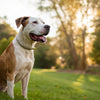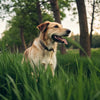Can I Feed My Dog After Exercise? Understanding the Right Timing for Optimal Health
- Houndsy
Table of Contents
- Introduction
- The Impact of Exercise on Your Dog’s Digestive System
- How Long to Wait Before Feeding Your Dog After Exercise
- The Best Types of Food to Serve Post-Exercise
- Signs of Digestive Distress to Watch For
- Tips for Establishing a Healthy Feeding Routine
- Conclusion
- FAQ
Introduction
Did you know that the timing of your dog’s meals can significantly impact their health and well-being? According to recent studies, feeding dogs too soon after exercise can lead to serious digestive issues, including bloat, which can be life-threatening. As responsible pet owners, we must understand how our furry friends' digestive systems work, especially after they've been active.
In this blog post, we will explore the critical relationship between exercise and nutrition for dogs, specifically addressing the question: Can I feed my dog after exercise? We’ll discuss the optimal timing for meals, appropriate food choices, and the physiological reasons behind these recommendations. By the end of this article, you’ll be better equipped to make informed decisions about your dog’s feeding schedule, ensuring they receive the nutrition they need while minimizing the risk of digestive problems.
We’ll cover the following key points:
- The impact of exercise on your dog’s digestive system
- How long to wait before feeding your dog after exercise
- The best types of food to serve post-exercise
- Signs of digestive distress to watch for
- Tips for establishing a healthy feeding routine
Let’s dive into the world of dog nutrition and exercise!
The Impact of Exercise on Your Dog’s Digestive System
Understanding how exercise affects your dog's digestive system is crucial for determining the right time to feed them. When dogs engage in physical activity, their bodies prioritize blood flow to the muscles and away from the digestive organs. This shift in blood flow can slow down the digestive process, making it essential to wait before feeding them after they've exercised.
How Exercise Affects Digestion
- Reduced Blood Flow: During exercise, the body directs blood toward the heart, lungs, and muscles. This means less blood flow to the stomach and intestines, which can impair digestion.
- Increased Risk of Bloat: Feeding immediately after vigorous activity can lead to bloating (gastric dilatation-volvulus), especially in deep-chested breeds. This condition can be fatal if not addressed promptly.
- Dehydration: After exercise, dogs may become dehydrated, which can lead to digestive issues. It’s important to ensure they hydrate before consuming food.
This understanding highlights why we should avoid feeding our dogs right after exercise and instead allow them some time to cool down and recover.
How Long to Wait Before Feeding Your Dog After Exercise
The general consensus among veterinarians and pet nutritionists is to wait at least 30 to 60 minutes after your dog has exercised before giving them a meal. This window allows their body to return to a resting state, promoting better digestion.
Factors Influencing Timing
- Intensity of Exercise: The more strenuous the exercise, the longer the waiting period should be. For instance, after a long run, it’s advisable to wait closer to an hour.
- Dog’s Age and Health: Puppies may need shorter waiting times due to their higher metabolism, while older dogs might require a longer period.
- Breed Considerations: Deep-chested breeds, such as Great Danes and Boxers, are at higher risk for bloat and may require additional caution.
By understanding these factors, we can tailor our feeding schedules to meet the unique needs of our individual dogs.
The Best Types of Food to Serve Post-Exercise
What your dog eats after exercise is just as important as when they eat. Choosing the right food can help replenish their energy and promote recovery.
Nutritional Needs After Exercise
- High Protein Content: After exercising, dogs need protein to help repair and build muscle. Look for foods that contain at least 26% protein to support recovery.
- Healthy Fats: Fat is a crucial energy source for dogs, especially those that are active. Incorporating fats into their diet helps with endurance and overall health.
- Hydration: Always ensure your dog has access to fresh water before and after meals to aid digestion and prevent dehydration.
Recommended Food Types
- Quality Kibble: Look for high-quality dog food brands that focus on real meat and whole ingredients.
- Raw Diets: Some pet owners choose raw diets that include fresh proteins and vegetables, which can be beneficial for active dogs.
- Homemade Meals: Cooking for your dog can be rewarding and allows you to control the ingredients. Be sure to include lean meats, vegetables, and whole grains.
No matter what feeding option you choose, always balance your dog’s dietary needs with their activity levels.
Signs of Digestive Distress to Watch For
Even with the best intentions, sometimes dogs may still experience digestive distress. Being aware of the signs can help ensure timely intervention.
Common Signs of Digestive Issues
- Bloating: A swollen or distended abdomen is one of the most serious signs and requires immediate veterinary attention.
- Vomiting: If your dog vomits after eating, it could indicate that their stomach is upset.
- Restlessness: If your dog seems uncomfortable or is pacing, it might signal digestive discomfort.
- Excessive Panting: Heavy panting can indicate pain or discomfort, especially after eating or drinking.
If you notice any of these signs, consult your veterinarian to rule out any serious conditions.
Tips for Establishing a Healthy Feeding Routine
Creating a consistent feeding schedule can help improve your dog's overall health and digestion. Here are some practical tips to consider:
- Set Regular Meal Times: Feed your dog at the same times each day to establish a routine. This promotes healthy digestion and can help your dog know when to expect food.
- Plan Exercise Around Meals: If your dog is due for a meal, plan their walks or playtime accordingly. Aim for exercise before a meal or after allowing adequate time to wait.
- Monitor Water Intake: Ensure your dog has access to fresh water before and after exercise. Hydration is key to healthy digestion.
- Pay Attention to Behavior: Observe how your dog reacts to their meals. If they seem uncomfortable or lethargic, you may need to adjust their feeding schedule or consult your vet.
These simple adjustments can make a substantial difference in your dog’s health and happiness.
Conclusion
Understanding the timing of meals in relation to exercise is essential for maintaining your dog's health. By waiting at least 30 to 60 minutes after exercise before feeding and choosing high-quality, nutritious food, we can help our pets recover effectively and avoid potential digestive issues.
As dog owners, we hold the responsibility of ensuring our furry companions are thriving. So, next time you take your dog out for a run or play session, remember to respect their digestive needs.
For those looking to enhance their dog feeding experience, we invite you to explore the Houndsy Kibble Dispenser. With its innovative design and functionality, it ensures that your dog receives perfectly portioned meals every time. Order your Houndsy Kibble Dispenser today!
FAQ
Q: Can I feed my dog right after exercise?
A: No, it’s best to wait at least 30 to 60 minutes after exercise before feeding your dog to allow their digestive system to settle.
Q: What should I feed my dog after exercise?
A: Focus on high-protein, quality dog food that includes healthy fats and plenty of hydration.
Q: How can I tell if my dog is experiencing digestive distress?
A: Watch for signs such as bloating, vomiting, restlessness, or excessive panting.
Q: Should I adjust my dog’s feeding schedule based on their activity level?
A: Yes, it’s important to tailor your dog’s diet and portion sizes based on their daily activity levels.
Q: Is it safe to give treats after exercise?
A: Treats can be given, but ensure they are healthy and do not replace a balanced meal. Always wait until your dog has cooled down before offering them.












